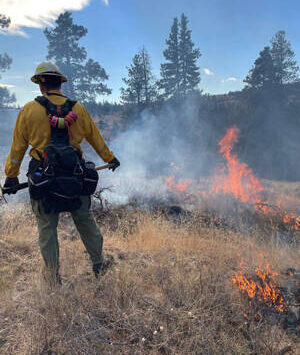OKANOGAN – The Okanogan Planning Commission okayed a preliminary recommendation for approval of the development agreement for phase one of a proposed development near Tonasket during their meeting on Monday, May 18 in the Commissioners Hearing Room.
The hearing started with an introduction from Perry Huston, director of Planning and Development. Huston told the Planning Commission that no decision had yet been made on the LUPA Appeal, which is an appeal of the SEPA (State Environmental Policy Act) approval.
Ben Rough, senior planner, then gave the Planning Commission a summary of the project, which has been through several changes. The development plan is now 88 lots with six phases and on 325 acres.
“The layout of the phases, the phasing plan and the density of the phases have been modified to become compatible with the airport and to obtain a legal source of water for each phase,” Rough said. “There was a site visit by Carter Timmerman of the Washington State Department of Transportation (WSDOT) Aviation Department who met with the proponent. Timmerman made recommendations to the proponent and they were included in the proposal. Timmerman now supports the proposal.”
Tim Verbeck Sibley, of Tonasket Homesteading LLC, then spoke to the board.
“We think this is our final version of the proposal and Eagle Canyon applications,” Verbeck Sibley said.
He then recounted the changes the development has gone through. He said one change has been that Tonasket Homesteading will use a state approved water source in each phase of the project. The development agreement will now have a 10-year timeline, rather than the originally proposed 20-year timeline.
“An irrigation water right was given in 1975 under the Family Farming act,” Verbeck Sibley said. “It now has four owners; two are involved in this proposal. The existing distribution system will still be used and will be issued to each property according to how many acres they have. We have to design a domestic water system which then has to be approved by state and country. In Eagle Canyon we will have one exempt well for a group B domestic water system.”
He said the water system will reduce the overall water use on the property compared to what is used currently because the households will use less water than an irrigation system on a farm. Verbeck Sibley said Tonasket Homesteading is confident the water system will have no affect on nearby water rights.
“In 30 years, there has been no documentation of water impairment,” he said. “Most importantly, the irrigation water comes from a separate water source then what the surrounding area is using. Lastly on the topic of water and mitigating affects, we’ve done a lot of testing on the irrigation wells that show they don’t have an affect on other irrigation wells.”
He then spoke about the Tonasket Airport and said Tonasket Homesteading has worked with the state Aviation Department and that it was very helpful to have Timmerman come out to the property and make suggestions for the proposal. Timmerman created a map for Tonasket Homesteading including all of the state guidelines which they have now included in their proposal. He said they’ve also incorporated information so that everyone who moves into the development knows there will be noise, lights and vibrations from the airport and that they can not complain about them later.
Homeowners will not be allowed to build reflective roofs and outside lights must be shielded or pointed down. Any structures built in the development must also submit forms to the Federal Aviation Administration, Verbeck Sibley said. As for traffic and road conditions, he said the roads will be built toward road standards from the county Department of Public Works.
“We are not connected to the airport road at all,” he added. “We have two separate connections to Pine Creek Road which are a half-mile apart.”
Verbeck Sibley said there will be a nonprofit homeowners association that will keep the standards of the development up to code. The development will also have a staff for maintenance of the water system and other repairs so Tonasket Homesteading will continue to be involved in the development after it’s finished.
“We haven’t set up the legal agreement yet but we are very committed to it,” Verbeck Sibley said. “We’re very interested in farming and want to keep this as farming land. Any future owners will have to sign a right-to-farm document. There is a cherry orchard that is surrounded by the development. We’ve set up the development to not disturb the orchard and our roads will give the owners of the orchard better access.”
As for Eagle Canyon, he said Tonasket Homesteading will set up rules to keep people safe around it and will designate the area as open space and a wildlife corridor. He said a geological assessment has been done and the report states there is no increased risk of cave-in due to development activities. He said the roads surrounding the orchard will provide 60 feet of right of way and that the Eagle Canyon open space will come up to the rim of the canyon.
When Verbeck Sibley was done with his presentation, Huston told the Planning Commission that he heard nothing during it that raised any red flags with him.
The Planning Commission than heard public testimony. Ed Jeffko of Tonasket, who has spoken before the commission before, said the proponents have bent over backward to make everybody happy and he thinks it’s time to move forward with this project.
Leroy Orr, president of the Tonasket Airport Improvement Club, said his interest is to protect the airport.
“I am very pleased the proponents have agreed to the state Aviation Department’s recommendations,” he said. “I talked to Carter Timmerman after his walk through with the proponents and he was impressed with the proponents’ efforts.”
Tami Tatom, the broker and owner of Okanogan Properties said she thinks developers come and go and that Tonasket Homesteading is taking a very great interest in their community and their impact on the community. She said she believes this development will be a very important addition to the community.
Robert Harris, an opponent of this development since the first hearing, then spoke to the commission.
“Wildlife fences are not going to work when they border my property,” he said. “The eight exempt wells are illegal. You can say the canyon isn’t hazardous, but one boy was killed in it. There’s still only one access; the two accesses proposed are on the same side and they are only a half-mile apart. If there’s a wildfire on that side, how are people going to get out?
“My biggest concern is I have the senior water right, I won’t be able to have livestock and this development will affect my water right,” Harris continued. “We’re in Superior Court right now arguing against the water rights. The judge has asked the proponents to resubmit and go back through the SEPA because the proposal has changed so much that it’s a different checklist.”
When Harris was done speaking, Wayne Verbeck addressed the commission regarding the death the opponents to this development keep mentioning.
“They keep referring to that boy who died in the canyon,” Verbeck said. “I was a fire commissioner at that time. This happened down in Webberville and it has nothing to do with Eagle Canyon.”
Deanna Strangburg of Tonasket told the commission she lived on the property proposed for the development for 10 years and she raised her children there.
“The canyon was never a problem,” she said. “I let my kids ride their horses there. I think this is a good project.”
Once the attendees finished speaking, the planning commission closed public testimony. Later on in the meeting, they approved a motion to completely close public testimony on this development.
Verbeck Sibley was then called forth to answer questions from the commission. During this time, he told the commission that the roads will be category three roads and will be surfaced, grav
el roads. He also said restrictions on livestock have not yet been finalized, but that this development is not meant to have neighbors affecting neighbors with livestock. He also said the way the covenant of this development has been written is that homes must be constructed up to the codes and quality standards of stick built homes.
After reading through the findings of fact, the development agreement and the conditions of approval, the planning commission passed a motion for preliminary recommendation for approval of the Development Agreement and directed staff to prepare documents for finalization. They also approved a motion for preliminary recommendation of preliminary approval for Phase I of Tonasket Homesteading subject to findings of fact, conclusions of law and condition of approval and also directed staff to prepare those documents for finalization.
The Planning Commission will review these documents again during their June 22 meeting and are expected to approve them to be sent to the Okanogan County Commissioners. The county commissioners will then begin the process of approving or denying the development proposal.




